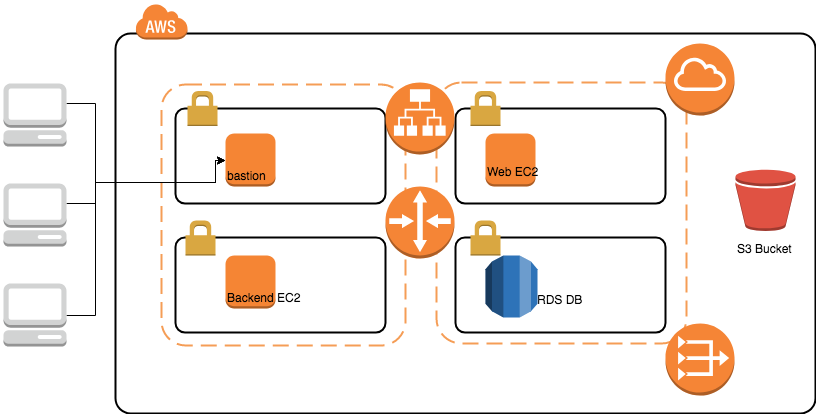Today we are going to practice a very simple scenario, create a VPC with different network topology, include public subnet and private subnet. And we will create bastion machine, Application Load Balancer with Web server, a backend machine inside the private subnet, a RDS server and also a S3 bucket.
Looks complicated, but it is designed to be a very wide usage sample for most general scenario.
For this workshop, we support 3 different region:
- N. Viginia(us-east-1)
- N. California(us-west-1)
- Tokyo(ap-northeast-1)
- Sydney(ap-southeast-2)
- Frankfurt(eu-central-1)
- London(eu-west-2)
Switch Region on the AWS console, a drag down menu near right-up corner. For example, we pick N. Viginia(us-east-1) for our lab practice.
-
Check if you already have a EC2 Key pair in your selected region.
-
If not, create one through AWS Console > EC2 > Key Pairs > Create Key Pair.
-
Remember to download the private key(.pem) and well saved.
-
In usual, we will move it into ~/.ssh/ sub-folder in your home directory.
-
To make it secure, remeber to change the privilege with command
chmod 0400 XXXXX.pem -
If you are windows user, and you should download putty.exe and puttygen.exe from Here. And also check the document Here if you don't know how to convert .pem to .ppk
- Create cloudformation stack: AWS Console > Cloudformation > Create Stack > from S3 template > https://s3-ap-northeast-1.amazonaws.com/workshop-data-public/cloudformation-workshop-20180731-vpc-bastion-rds.cfn.yml
- For the stack configuration:
- Stack Name: Whatever you want to name
- Environment: dev
- Availability Zone 1: Pick 1 AZ
- Availability Zone 2: Pick a different AZ
- EC2 Key Pair: Select the Key Pair Name you setup in Step 2.
- DB User/DB Password/DB Name: Please remember what you input.
- Wait till the stack creation ready, the status will change to
CREATE_COMPLETE
- Check your VPC
- Check the CloudFormation Stack, there will be a nested stack name as "VPC"
- You can find a new VPC is created
- You will find different subnet, with different property and setting.
- You will find public subnet and private subnet.
- Find your Bastion
- Check the CloudFormation Stack, there will be a nested stack name as "bastion"
- Inside your VPC created in Step 4, there is new EC2 in public subnet.
- You can try to remote into that instance.
- use SSH
ssh -i XXXX.pem ec2-user@YOUR_BASTION_IP
- Find your RDS (or Aurora)
- Check the CloudFormation Stack, there will be a nested stack name as "bastion"
- Did you remember the account and password you set in the cloudformation?
- try to login into your database with following command
mysql -u DBUSER -h DBADDRESS -p
- Try to create a web server and backend server
- Create cloudformation stack: AWS Console > Cloudformation > Create Stack > from S3 template > https://s3-ap-northeast-1.amazonaws.com/workshop-data-public/cloudformation-workshop-20180731-alb-ec2.cfn.yml
- For the stack configuration:
- Stack Name: Whatever you want to name, suggest we have "EC2" within the Name
- Key Name: Pick the same name from Step 2.
- VPC: Pick the new VPC we created at Step 3.
- SSHAllowCIDR: Follow the VPC CIDR
- Public Subnet 1: Pick one subnet with "public" in name
- Public Subnet 2: Pick another one with "public" in name
- Private Subnet: Pick one subnet with "private" in name
- Wait till the stack creation ready, the status will change to
CREATE_COMPLETE
- Check your web service stack
- You will find an Application Load Balancer, A web server and a backend server, and also a S3 bucket.
- In this practice, you can see how to create resource for our basic practice. You can try to understand how we design the network topology, how we devide AZ and subnet.
- Also, we talked about the security group.
- By default, all the network routing rule has been pre-defined, you don't need to do anything.
- In this empty stack, you can see what we showed in the first diagram.
- Go to Cloudformation, select your stack and delete stack.
- Remember to delete the EC2 one, and the delete the based one.
